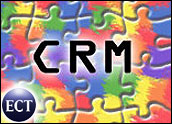
In the early days of the dot-com boom, companies tracked “hits” and “eyeballs” and measured “stickiness” on their hastily created Web sites. As Web sites matured into viable business channels, however, these simple Web metrics proved to be of little value. Just as the customer data generated through operational CRM systems must be analyzed in order to turn it into useful customer intelligence, the same is true for Web customer data.
Many organizations continue to suffer from the gap between basic Web metrics and the advanced Web analytics that are necessary to produce actionable customer insight.
While the measurements that many organizations rely on provide superficial metrics, they don’t help to increase customer understanding or, for example, determine how online customers compare to customers in other channels.
A simple site visit tally doesn’t give a marketer enough customer information to take action. Marketers need information that answers questions like: Does more traffic mean that marketing spend is more effective? Are more of the right customer segments being attracted to the site? How can I use marketing spend to enhance ROI?
Greater Insight
Progressive companies know that basic traffic statistics don’t tell the whole story. In order to gain greater insight into customer behavior on the Web, companies need to expand their analytical CRM strategies beyond basic Web metrics to include customer-focused analytics.
Here are some questions to consider when developing a Web measurement and analytical strategy:
Many leading organizations are tackling this issue today. Understanding the range of Web analytics available will help you select the appropriate software or application to implement your strategy.
End Result
Although developing a Web-analytics strategy and selecting the right analytics may seem overwhelming, the end result most often proves to be worth the effort.
A case in point is Sofmap Company, one of Japan’s leading computer retailers. Sofmap discovered that its online customers had difficulty making hardware and software purchasing decisions, which was hindering the company’s online sales. The company used SPSS predictive Web analytics, based on the Clementine data mining workbench, to build an engine that recommends appropriate products based on customer profiles, which are created with information gathered during the online registration process and from past transactions. After the predictive recommendation engine went live, page views increased by 67 percent per month, and Sofmap’s online profits increased 300 percent.
In another example, Thomas Cook, which ranks among the world’s leading international travel groups, used Web analytics to generate online customer behavior reports and analyze why some customers had unsatisfactory visits.
Using NetGenesis Web analytics from SPSS, Thomas Cook was able to turn a mass of raw, unmanageable Web data into actionable knowledge. As a result, the number of site visitors increased by 100 percent over the previous year, and click-through rates and sales doubled.
As these success stories demonstrate, the Web is indeed a viable business channel. It offers more detailed customer data in one convenient place than any other channel, providing a wealth of information on how customers think, act, browse and purchase.
To tap into this information gold mine, however, companies must include Web analytics strategies in their broader analytical CRM strategies, and fill in the gap between simple Web metrics that provide counts and advanced Web analytics that provide predictive customer insight. With this multichannel, full-view approach, both companies and their customers will reap measurable rewards.
Colin Shearer is vice president of Customer Analytics for SPSS.







































